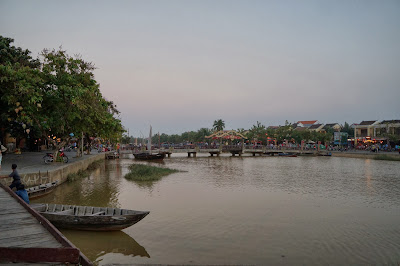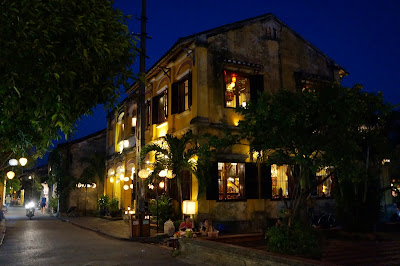The easy way to get to Hoi An from Ho Chi Minh City is to fly to Danang then go via car for the final leg. Then there's my way.
We had to wake at 5.30 am to get ready for a 6.15 departure from the hotel. A hotel car took us the few kilometres to the domestic terminal at the airport, where we checked into our Vietnam Airlines flight to the central Vietnam city of Hue.
The airport was nothing flash, but it seemed functional. Alex had sandwiches (refused banh mi) for breakfast, then we went to the gate. Our blue Airbus A321 was parked at a remote stand, which necessitated a packed shuttle bus ride.
It was nice to be aboard a full service airline again, even if the service was just a cup of water. We took off over the hazy skies of Ho Chi Minh City and for most of the smooth flight were cruising over a carpet of cloud.
We descended over mountains poking their heads through the cloud, across lakes and paddy fields and over the beach. It was lovely scenery.
Hue's supposedly international airport had just emerged from a runway resurface, but the the terminal was still tiny with no air bridges. After descending down the stairs we had to catch an airport bus again for a distance that could easily have been walked.
With no luggage to collect we raced straight out to catch the Mai Linh taxi waiting at the stands, ignoring the calls of the other taxi drivers.
It felt longer than a 14 kilometre ride into the centre of Hue. The route in was fascinating, with lots of old shop houses and two or more storey residences with interesting facades, temples and roadside food carts. It felt a little like Thailand and very tropical.
I would love to see more of Hue, with its imperial citadel and tombs, but our next stop was the railway station. Despite my concerns, we were early, and there was enough time for a meal of "breakfast" at one of the small food shacks opposite the station.
We ordered two bowls of pho and they were delicious, the stock having a strong scent of lemongrass that is absent into the Australian versions.
Then we sat in the waiting room of the train station with all the other passengers, many of them westerners. Alex amused himself at the fish tank while we waited. And waited.
The station toilets smelled like China, a very difficult scent to remove from your nostrils once it is lodged there.
Everyone was told to move into the second waiting room after having their tickets checked. There we waited again. The train was delayed by an hour and a half. I bought Alex a pack of chocolate biscuits and read him another chapter of the Horrid Henry e-book on my phone.
Time now to move out on to the heat of the platform and wait. I loved the slightly rundown air of the station.
Eventually, the diesel hauled train arrived hauling grungy carriages. The carriage attendant helped people up the steep carriage steps, the platform being level with the tracks. One older European lady had, in addition to a couple of smaller bags, a big case. It just reminded me of how glad I was that our luggage was only carry ons. The case blocked the aisle until it was somehow forced into an overhead rack.
The web descriptions that I'd read didn't do justice to the rundown interior of the "soft seat" compartment, but it wasn't uncomfortable, just not clean like a Japanese train. We were seated in the middle of the train where the seats swap directions, B facing forwards and Alex and I seated backwards. The window was rather smudged, so many photos will seem out of focus.
We rattled back along the direction we came from the airport, out through the suburbs of Hue. Alex was fast asleep. There was local life out of the window, farm houses, rice fields, banana palms, chickens and buffaloes.
Eventually we reached the breathtakingly scenic Hai Van Pass section of the line, where it climbs its way high into the mountains and winds its way around the coast, with views of the ocean and beaches and boulders below. Though it's a slow ride, that just gives you more time to appreciate the view.
At each tunnel an attendant waits. I wonder if they live in those little huts, disconnected from the rest of the world except by train.
The descent back to sea level is surprisingly quick, then we approach the port city of Danang, which feels more modern than Hue. Soon enough we are at the station to be met by a driver from out hotel.
So now I've added another railway to my list and have ensured that my record of a train in every country I've been to is maintained. But that detour was worth it, just for the magnificent scenery.
The 40 minute drive to Hoi An took us past palm lined beaches and open air seafood restaurants that seemed made for a lazy meal of crab overlooking the ocean and past the Marble Mountains with their marble statue shops at their bases and pagodas up their slopes.
As soon as we arrived in little Hoi An we knew we'd like it. Our hotel, the Ha An, itself looks like colonial shophouses with a tropical courtyard. After welcome drinks of dragonfruit juice and a fruit platter, we were taken to our gorgeous little room, where petals were scattered on the bed and were placed elsewhere. It felt so tropical, so luxurious.
Yet we couldn't stay long, for there was much to explore. Eschewing the bikes for now, we walked in towards the old town. This is obviously a tourist town with lots of clothes and knick knack shops, bars and restaurants, and white skinned people strolling along the streets or riding bicycles or scooters. But it is so much nicer than Chiang Mai, for instance, as most of the places seem to be about Vietnamese food and crafts rather than catering for homesick westerners.
A lot of clothes are made or tailored here. B bought some dresses, alterations not a problem, that fit her so much better than at home. We bought rambutan from the fruit market near the river where touts offered rides on sampans. As the red sun set across the water we ate local wontons and spring rolls from little stalls alongside the river.
Then, with Alex asleep on my shoulder, we crossed the bridge to lantern lit An Hoi where there were more bars and more touristy shops, but lovely views of the riverboats back at Hoi An. Back across to Hoi An, the Lonely Planet finally came good with a recommendation for Morning Glory, where we had a big dinner of local dishes, including our favourite, the eponymous salad. An atmospheric night stroll returned us to our hotel, but first we stopped by a used bookshop, where Alex made friends with the owner's young kid.
So far we are loving this town, and I'm glad we took the long way round to get here.















































Comments
I've commented on a couple of your posts in the past, and just wanted to say - WOW! I was *this* close to going to Vietnam (and specifically, Hoi An/Da Nang/Saigon) in November, but a cheap Jetstar sale made me end up planning a trip to Japan/South Korea again. Now I really want to go to Hoi An! Money is looking pretty good at the moment, so I may need to head over there in late January/early February, I think...
Just as a rough idea, how much did you budget each day for hotels and food, etc.? I'm a fairly frugal traveler, where I only really purchase food and travel expenses, rather than stacks of souvenirs, and just wanted to make sure that it would all still be within a suitable budget.
Keep up the amazing reports - they're so inspiring and really make me want to travel!
I found the prices in the Lonely Planet to be quite inaccurate.
Hoi An was a special place and I think Hue has the potential to be one too. Ho Chi Minh felt a bit like Yet Another South East Asian City but we were only a short time there. I suspect that we will probably place travel to Japan again ahead of a return to Vietnam as it is much easier to be an independent traveller, the shopping is better, and the sights seem to be infinite.
Thanks for the budgeting tips! I'll keep that in mind. That's pretty much what I budgeted for. I think I could comfortably do a 2 week trip for about $3,000 including flights, visas, accommodation, food, transport, spending money and travel insurance, especially if I stuck to the cheaper/family-run hotels.
And yes, your posts about Japan keep showing me all of these amazing things that I need to do! I'm going to be in the Kansai region in November, and we're going to do a daytrip to Okunoshima, or "Rabbit Island", as we live in Queensland and can't have rabbits as pets, and find them adorable. I doubt it'll take a whole day though, so I might see if we can squeeze in a look at that ropeway and the town of Arima on the way back to Osaka.
One of my motivations to do a trip to South East Asia (aside from all of the amazing sights to see) would be to fly on an A340 - one of the last of the Airbus family that I'm yet to fly on, and they're near-impossible to fly on from Brisbane.
Lufthansa flies them 3 times a week between BKK and SGN, so I'd probably fly Qantas/Emirates into Bangkok, then catch the Lufthansa flight to HCMC, then fly up to Hoi An, and then back to HCMC. Then I'd probably travel overland through Cambodia, spending a while at the temples of Angkor, before returning to Bangkok to catch the Qantas/Emirates flight home.
This is once again all up in the air at the moment - depends on how many projects I get through - the life of a freelancer makes these things hard to predict!
I've done an A340 once - Thai Airways SYD-BKK on a A346 and it was a great flight. As you like Japan so much you might want to consider visiting Taiwan, which is similar but different. I saw plenty of China Airlines A343s in the Asian airports on this trip so that could be an alternative. There are so many options when hopping around Asia!